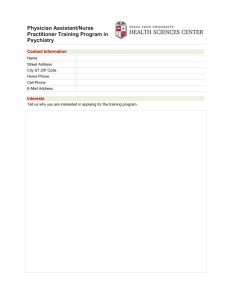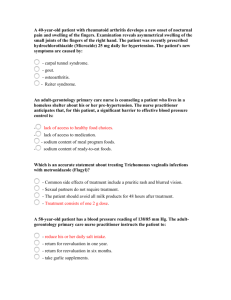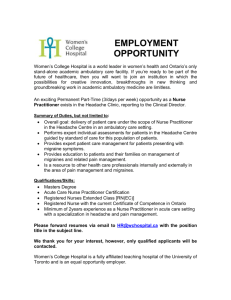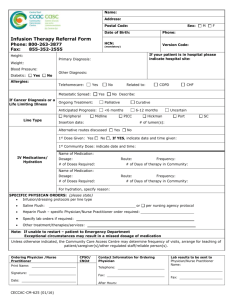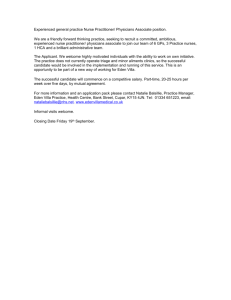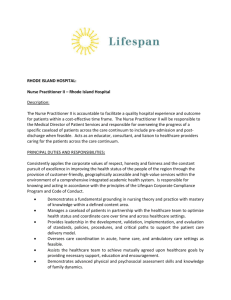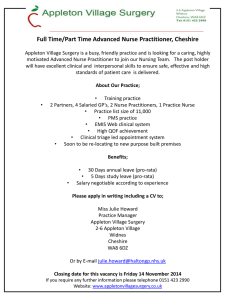Sample Nurse Practitioner Consultation Practice Agreement
advertisement
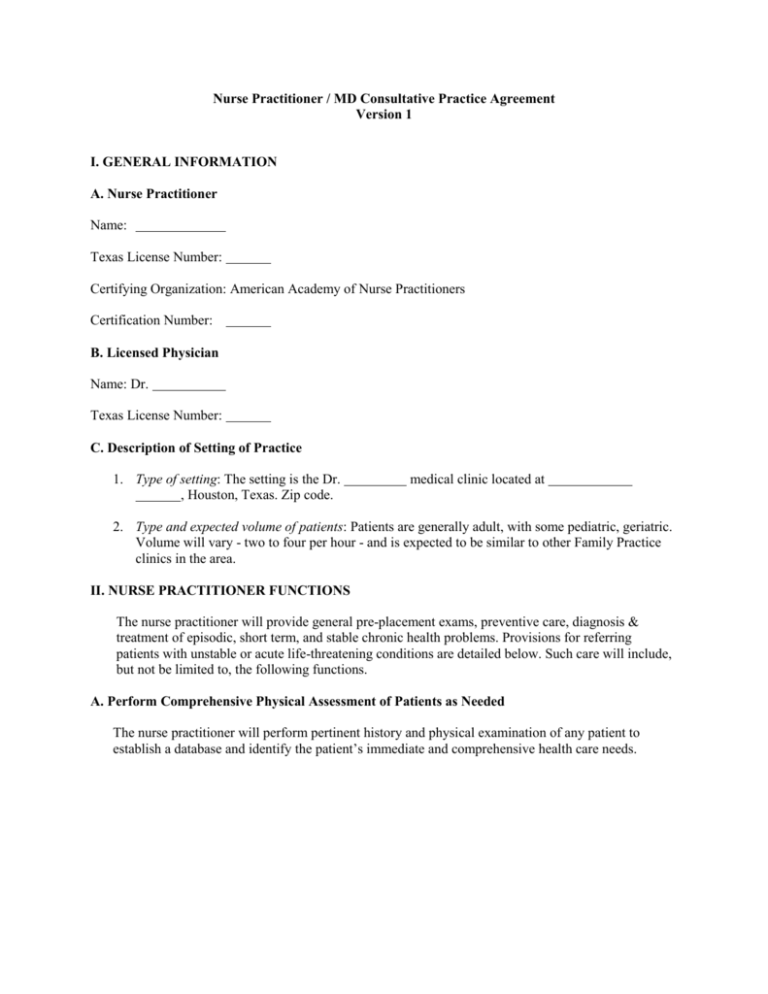
Nurse Practitioner / MD Consultative Practice Agreement Version 1 I. GENERAL INFORMATION A. Nurse Practitioner Name: Texas License Number: Certifying Organization: American Academy of Nurse Practitioners Certification Number: B. Licensed Physician Name: Dr. Texas License Number: C. Description of Setting of Practice 1. Type of setting: The setting is the Dr. , Houston, Texas. Zip code. medical clinic located at 2. Type and expected volume of patients: Patients are generally adult, with some pediatric, geriatric. Volume will vary - two to four per hour - and is expected to be similar to other Family Practice clinics in the area. II. NURSE PRACTITIONER FUNCTIONS The nurse practitioner will provide general pre-placement exams, preventive care, diagnosis & treatment of episodic, short term, and stable chronic health problems. Provisions for referring patients with unstable or acute life-threatening conditions are detailed below. Such care will include, but not be limited to, the following functions. A. Perform Comprehensive Physical Assessment of Patients as Needed The nurse practitioner will perform pertinent history and physical examination of any patient to establish a database and identify the patient’s immediate and comprehensive health care needs. B. Establish Medical Diagnosis for Common Short-Term or Chronic Stable Health Problems The scope of practice of the nurse practitioner will depend upon the category of problem(s) and will become clear by the delineation of the following categories of problems: - - - For common acute, chronic stable conditions, the nurse practitioner will diagnose, manage, and treat, including prevention and patient education. Examples of these would be upper respiratory infections, pharyngitis, otitis media, common skin conditions, and management of chronic problems such as asthma and diabetes mellitus uncomplicated. For uncommon or unstable conditions, the nurse practitioner will participate in the diagnosis with consultation and either refer to a specialist or participate in the dual management and treatment with a consultant. Examples of these would be fractures and acute severe abdominal pain. For acute life-threatening conditions, the nurse practitioner would provide a working diagnosis, institute emergency management, and immediately refer to a secondary care center. Examples of these would be status asthmaticus, airway obstruction, and cardiac arrest. C. Order, Perform, and Interpret laboratory Tests (Including Diagnostic and Invasive Procedures) The nurse practitioner will order and interpret any test(s) necessary to the medical evaluation. Examples of laboratory and diagnostic tests that the nurse practitioner orders, performs, and/or interprets: - Orders and interprets: Complete blood count, serum chemistry, thyroid function tests, EKG Performs: EKG, minor surgical procedures Orders: Chest X-ray The nurse practitioner has 15 years of experience in ordering, performing, and interpreting diagnostic tests and has had didactic training in a baccalaureate nursing program, in emergency room and pre-hospital training, as well as advanced preparation in a master’s program as a nurse practitioner, and through continuing medical education in interpreting laboratory data. D. Prescribe Drugs The nurse practitioner will prescribe drugs as necessary and appropriate for a family practice office, in accordance with state and federal law. Examples of classes of drugs to be prescribed are antihypertensives, antianginals, antibiotics, bronchodilators, diuretics, and analgesics, including controlled dangerous substances (CDSs). The nurse practitioner may order any CDS covered by the nurse practitioners DEA permit. This includes all classes applied for: That is, all but experimental drugs. Specifically, the nurse practitioner prescribes analgesics, such as Tylenol with codeine, benzodiazepines, and certain weight reduction medications that include amphetamines. CDS's will be limited to short-term, acute episodes, such as migraine headache. 1. Schedules III-V; 2. a maximum 30-day supply with no refill; 3. additional prescriptions for the individual, only with prior consultation with the physician; and 4. for persons younger than 2 years of age only after prior consultation with the physician. E. Perform Therapeutic and Corrective Measures The nurse practitioner will order and may perform such therapeutic measures as are appropriate for a family practice: for example, patient education, cleaning and dressing of superficial wounds, splinting, and irrigation of ears and eyes. F. Emergency Care The nurse practitioner will perform cardiopulmonary resuscitation as necessary until emergency vehicle arrive. The nurse practitioner successfully completed the national cognitive and skills examination in accordance with the Standards of the American Heart Association for Course C, Basic Life Support, in November 1997. III. NURSE PRACTITIONER/PHYSICIAN RELATIONSHIP A. Referrals The nurse practitioner will evaluate, diagnose, manage, and treat common acute and chronic stable conditions as described in Section II.B. above, seeking consultation as deemed necessary. In dealing with uncommon or unstable conditions as described in Section II.B, the nurse practitioner will take the history, do the physical exam, obtain laboratory and other necessary data, participate in the diagnosis with consultation, and either refer to the physician consultant or to a specialty clinic or secondary treatment center in dual management and treatment with a physician consultant or specialty clinic. In dealing with acute life-threatening conditions as described in Section II.B. above, the nurse practitioner will take a history, do the necessary initial physical exam, make a working diagnosis, institute emergency management, and immediately refer to the nearest emergency department. B. Drug and Medical Guidelines The nurse practitioner will collaborate with the physician in establishing and reviewing drug and other medical guidelines. Review of guidelines will be done in a continuing manner, but no less frequently than annually. C. Schedule for Review The nurse practitioner will review and discuss medical diagnosis and therapeutic or corrective measures employed in a continuing manner when the dual management method of care is employed. The nurse practitioner and physician will review and discuss patient care management no less than monthly. D. Schedule for Consultation, Record Review, Cosigning of Records The physician will be in attendance at the practice daily, except when on leave, and generally be available for consultation, record review, and cosigning of records as needed in the discretion of the nurse practitioner. E. Availability of Physician for Consultation The physician consultant will be available in person or by telephone on an as-needed basis in order to consult with the nurse practitioner on diagnosis and treatment of medical problems. In the event that the physician is on leave, the physician will designate another physician who will be available to consult with the nurse practitioner as needed. IV. AUTHORIZATION The nurse practitioner shall submit a new amended written agreement for approval before altering the practice setting or modifying or expanding the medical functions that the nurse practitioner is authorized to perform. (Authority: C.O.M.A.R. 10.27.07) Nurse Practitioner: Date: Physician: Date:
